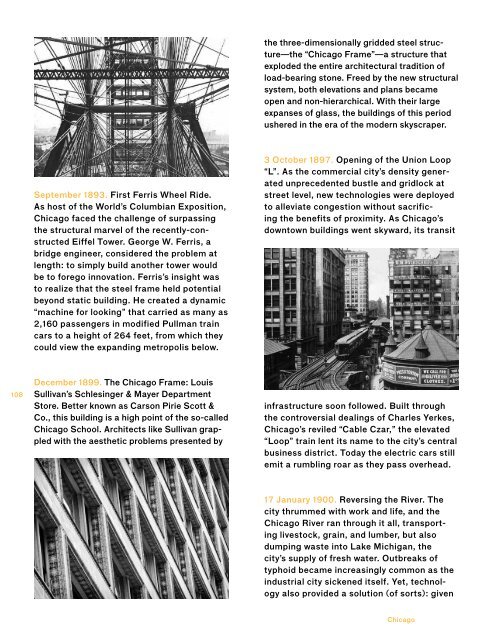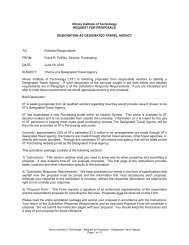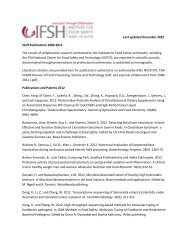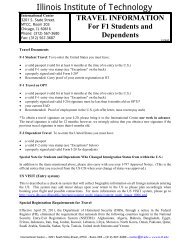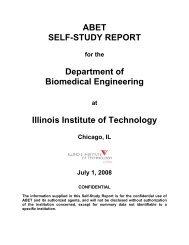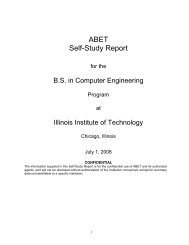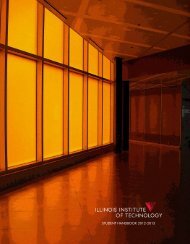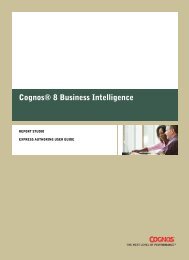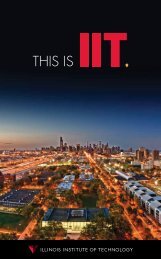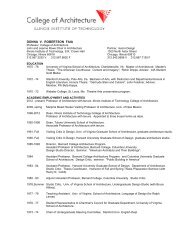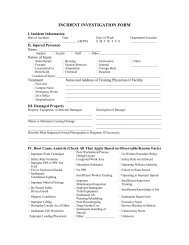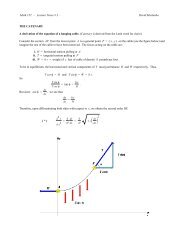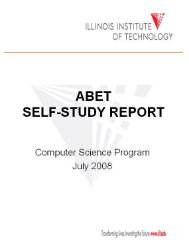Nowness - Illinois Institute of Technology
Nowness - Illinois Institute of Technology
Nowness - Illinois Institute of Technology
Create successful ePaper yourself
Turn your PDF publications into a flip-book with our unique Google optimized e-Paper software.
108<br />
September 1893. First Ferris Wheel Ride.<br />
As host <strong>of</strong> the World’s Columbian Exposition,<br />
Chicago faced the challenge <strong>of</strong> surpassing<br />
the structural marvel <strong>of</strong> the recently-constructed<br />
Eiffel Tower. George W. Ferris, a<br />
bridge engineer, considered the problem at<br />
length: to simply build another tower would<br />
be to forego innovation. Ferris’s insight was<br />
to realize that the steel frame held potential<br />
beyond static building. He created a dynamic<br />
“machine for looking” that carried as many as<br />
2,160 passengers in modified Pullman train<br />
cars to a height <strong>of</strong> 264 feet, from which they<br />
could view the expanding metropolis below.<br />
December 1899. The Chicago Frame: Louis<br />
Sullivan’s Schlesinger & Mayer Department<br />
Store. Better known as Carson Pirie Scott &<br />
Co., this building is a high point <strong>of</strong> the so-called<br />
Chicago School. Architects like Sullivan grappled<br />
with the aesthetic problems presented by<br />
the three-dimensionally gridded steel structure—the<br />
“Chicago Frame”—a structure that<br />
exploded the entire architectural tradition <strong>of</strong><br />
load-bearing stone. Freed by the new structural<br />
system, both elevations and plans became<br />
open and non-hierarchical. With their large<br />
expanses <strong>of</strong> glass, the buildings <strong>of</strong> this period<br />
ushered in the era <strong>of</strong> the modern skyscraper.<br />
3 October 1897. Opening <strong>of</strong> the Union Loop<br />
“L”. As the commercial city’s density generated<br />
unprecedented bustle and gridlock at<br />
street level, new technologies were deployed<br />
to alleviate congestion without sacrificing<br />
the benefits <strong>of</strong> proximity. As Chicago’s<br />
downtown buildings went skyward, its transit<br />
infrastructure soon followed. Built through<br />
the controversial dealings <strong>of</strong> Charles Yerkes,<br />
Chicago’s reviled “Cable Czar,” the elevated<br />
“Loop” train lent its name to the city’s central<br />
business district. Today the electric cars still<br />
emit a rumbling roar as they pass overhead.<br />
Chicago’s unusual geological situation, it<br />
was possible through massive infrastructural<br />
work to do the impossible and reverse the<br />
river’s flow away from the lake. The highly<br />
contested project secured clean water for<br />
generations <strong>of</strong> future Chicagoans, but only by<br />
redirecting the negative impact <strong>of</strong> the city’s<br />
success onto others.<br />
1909. Traffic on Dearborn and Randolph.<br />
Chicago has always been a logistics center.<br />
Historically overlaid networks <strong>of</strong> water, rail,<br />
highway, and air travel make today’s city a<br />
major node in the vast systems <strong>of</strong> global<br />
commerce. More than natural forces, the<br />
flow <strong>of</strong> goods and people have shaped the<br />
metropolis’s architecture and landscape. At<br />
the turn <strong>of</strong> the twentieth century the city <strong>of</strong><br />
trade turned hypertrophic: life in Chicago’s<br />
center reached an unprecedented, even<br />
notorious, density. Later decades, however,<br />
would demonstrate that urban development<br />
is not unidirectional, but involves cycles <strong>of</strong><br />
densification and disaggregation, <strong>of</strong> ebb and<br />
flow, over the life <strong>of</strong> the city.<br />
1909. Plan <strong>of</strong> Chicago. Co-authored by<br />
Daniel Burnham and Edward Bennett, the<br />
Plan <strong>of</strong> Chicago challenged the non-hierarchical<br />
grid on which the city had grown,<br />
proposing instead a Baroque composition <strong>of</strong><br />
plazas, avenues, and parks arranged symmetrically<br />
around an artificial harbor and<br />
civic center. Though many elements were<br />
never realized, the plan articulated far-reaching<br />
goals that guided Chicago’s development<br />
throughout the twentieth century: the preservation<br />
<strong>of</strong> the lakefront for public use, the<br />
expansion <strong>of</strong> parks and forest preserves, and<br />
the creation <strong>of</strong> cultural centers. The Plan<br />
demonstrates that the importance <strong>of</strong> utopian<br />
visions rests not in the details <strong>of</strong> their execution<br />
but in their power to direct the course <strong>of</strong><br />
metropolitan development.<br />
109<br />
17 January 1900. Reversing the River. The<br />
city thrummed with work and life, and the<br />
Chicago River ran through it all, transporting<br />
livestock, grain, and lumber, but also<br />
dumping waste into Lake Michigan, the<br />
city’s supply <strong>of</strong> fresh water. Outbreaks <strong>of</strong><br />
typhoid became increasingly common as the<br />
industrial city sickened itself. Yet, technology<br />
also provided a solution (<strong>of</strong> sorts): given<br />
14 February 1929. St. Valentine’s Day<br />
Massacre. Prohibition brought celebrity,<br />
riches, and violence to Chicago gangland<br />
bosses like Al Capone and Bugs Moran,<br />
whose rival factions controlled the city’s<br />
booze traffic, brothels, and casinos. With its<br />
conspiracy theories, complicit cops, and suspects<br />
who went uncharged, the St. Valentine’s<br />
Chicago<br />
Chicago


